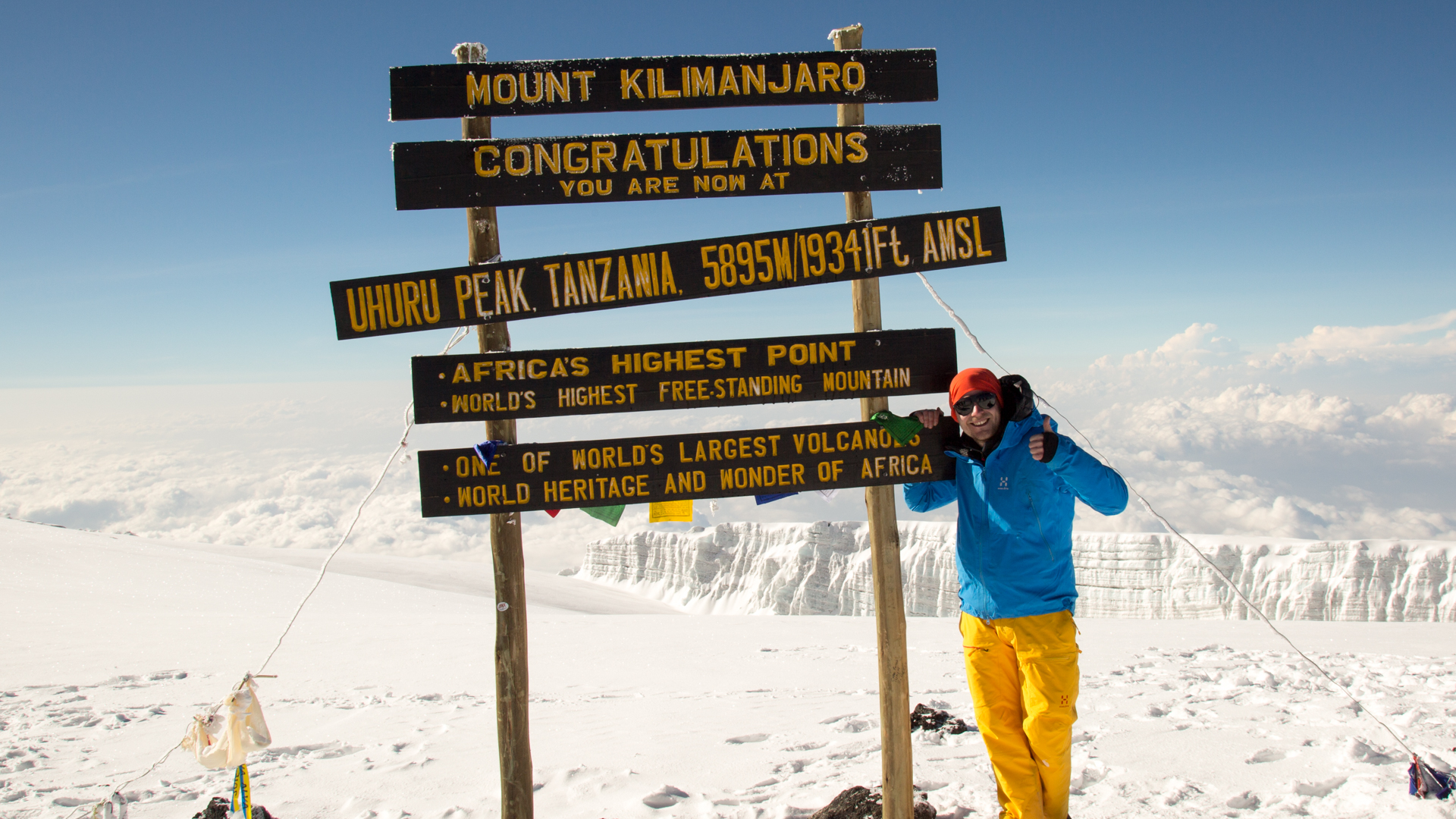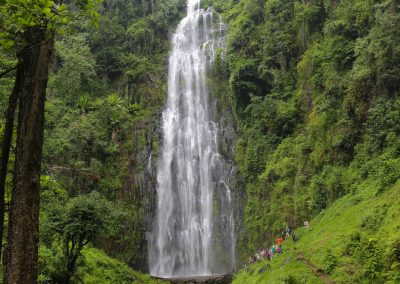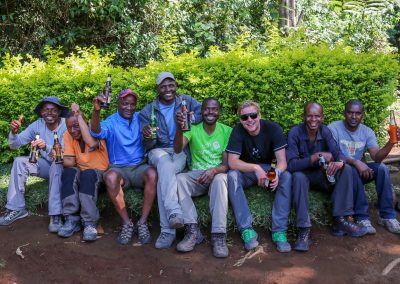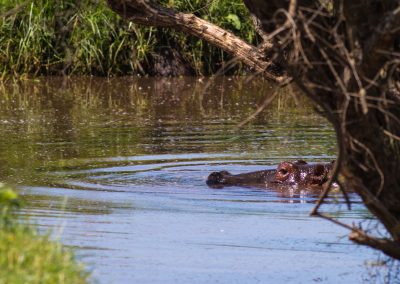About
The highest point in Africa, Kilimanjaro, is perhaps one of the best-known mountains in the world. It is the easiest of the Seven Summits and definitely the most romantic!
Kilimanjaro is like an island, standing tall and sentinel surrounded by the hot, dry plains of Tanzania. An expedition to climb the world’s highest free-standing mountain is a veritable smorgasbord of African culture and scenery, providing a fabulous excuse to visit this wild continent.
Kilimanjaro was one of the first mountains I climbed, and I was captivated immediately. The combination of the beautiful scenery, the people, and the wildlife is unbeatable!
Date and price
The best time to climb Kilimanjaro is during the dry seasons when the weather is more stable and clear. This is typically during the dry seasons, which extend from December to March and from June to October. During these months, there is less rain and fewer clouds, providing better views and more comfortable weather for hiking. It’s also important to avoid the rainy seasons as the trails can become muddy and slippery, making the climb more challenging and less safe.


Day 1
Arrival
The group arrives at Kilimanjaro Airport (JRO). Participants are met by our representative and transferred to a Aishi Machame hotel, which is beautifully situated on the slopes of Mount Kilimanjaro.
Day 2
Materuni Waterfall
Acclimatization day. Begin the day with a short drive up onto the slopes of Kilimanjaro, to the village of Materuni, approximately 1,800 m above sea level. This lush rainforest region is known for producing some of the best coffee in East Africa. Start the day with a visit to a small coffee farm and learn about how the coffee is grown, harvested and processed locally. Try your own hand at processing, roasting and preparing a fresh cup of coffee in the local Chagga way
Once you have finished enjoying your coffee break, you will depart on a beautiful 45 minute hike through the hills and valleys en route to the waterfalls. Along the way your guide will teach you about local plants and how they are used for food and traditional medicine, as well as giving you more insight into the local Chagga culture.
The waterfalls are hidden in a pristine valley with cliffs towering up to 200ft overhead. The water falls straight down in a curtain to land in a small pool where you can relax, take lunch and go for a swim in the chill mountain waters.
After the falls hike you will return back to the car and return to the hotel
Day 3
Machame Camp
A guide and a mountain support crew will arrive at the hotel in the morning in order to meet you and hold a quick briefing, after which you will travel by vehicle to Kilimanjaro National Park’s entrance: Machame Gate (1,800 m). After the quick formality of acquiring climbing permits and registering with the search and rescue service, the group will start trekking up toMachame Camp (3,010 m). The trekking route includes passage through the rainforest (where tropical showers are highly probable), so we recommend you take not only spare clothes, but also your raincoats.
Day 4
Shira Camp
After breakfast you will start trekking up to the second high-altitude camp, Shira Camp (3,845 m). On this day you will emerge from the rainforest and for the first time be able to see stunning views of the Shira Plateau laid out in front of you. Physically speaking, the trekking is not very difficult, but you may feel the changes in altitude, so pay attention to your body and remember that choosing the proper pace is extremely important for good trekking. When you reach the camp, you will have lunch and some rest, after which the group will go on an acclimatization hike towards Lava Tower Camp with a 300-meter gain in altitude. Back down at Shira Camp you will be served a hot dinner.
Day 5
Barranco Camp
After breakfast you will leave Shira Camp (3,845 m) and start your way to the key point of the route: Lava Tower (4,630 m). This section of the route has a lot of ascents and descents that end in a camp at over 4,600 meters. It might be difficult, and you may feel some discomfort, but in order to successfully acclimate to the altitude you have to spend at least 1–2 hours here, so this is where lunch will be.
Then you will descend to Barranco Camp (3,960 m). Here you can see the famous Barranco Wall, impressive in both its massive size and steepness! Next day you will be climbing it, but don’t worry: it features a very simple hiking trail.
Day 6
Karanga Camp
On this day it is best to make an early start to avoid crowding on the way up Barranco Wall. Despite the Wall’s seemingly daunting height and steepness the actual climb is rather merciful at a mere hour or so. The top provides a great photo opportunity with Kibo Peak as the backdrop.
The next part of the day is rife with ups and downs where your guides will choose the best place for individual climbers. A lunch break at Karanga Camp shall be followed by an acclimatization climb towards Barafu with its highest point being 4,270m. The group then drops back to Karanga Camp for the overnight.
Day 7
Barafu Camp
After breakfast you begin your way to Barafu Summit Camp (4,640 m). Our team will set up a camp for you ahead of time, including tents and sleeping bags, so you can relax. After regaining strength, you have to complete an acclimatization climb towards the intermediate Kosovo Summit Camp with its highest point being 4,800 m and then back to Barafu Camp, where you will be served a hot dinner. It is better to spend the remainder of the day resting and sleeping before night summiting.
Day 8
Summit – Uhuru Peak!
Summiting starts around midnight from 4,635 m, ending on Uhuru Peak at 5,895 m. While the trek itself is fairly simple, rarified mountain air does pose a challenge. Therefore, a guide who will monitor their condition throughout the climb shall accompany every two climbers ensuring safety above all. Upon summiting, you shall have an opportunity to walk on the nearby glacier.
The descent to 3,820 m at Millennium Camp starts after a two-hour rest back at Barafu Camp.
Day 9
Mweka Gate
The camp is situated in a tropical rainforest. When you wake up, you will feel relief from the reduction of the height and the satisfaction of reaching the summit. After a warm breakfast, you will head for the park’s exit: Mweka Gate (1,640 m). After your descent the whole group will gather to congratulate you, followed by offering you a chance to share your opinions on the climb in the guestbook. Provide you a transfer back to the hotel. Upon completing your transfer, a celebratory toast with sparkling wine awaits you at the hotel, followed by a refreshing dip in the pool. Conclude the evening with a delectable dinner and beverages at the hotel’s esteemed restaurant.
Day 10
Safari och departure
After a restful morning, you kick off your day at 10 am with a visit to African View Lodge for a delicious lunch. Fuelled up, you embark on a thrilling afternoon safari in Arusha National Park with our guides in our own private jeeps. Enjoy yourself in the park’s diverse beauty, from vast acacia savannahs to the shimmering Momella Lakes and the majestic Mount Meru, Tanzania’s second-highest peak. Keep your eyes peeled for fascinating wildlife like monkeys, zebras, giraffes, waterbuck, and buffalo. With a bit of luck, you might even spot a majestic leopard! The birding here is incredible, with over 400 species including the iconic pink flamingos. As the day winds down, we head to the airport for a final farewell dinner before catching our flight back home.
Day 11
Arrival
Back home with the memories of a great adventure in your backpack.

























